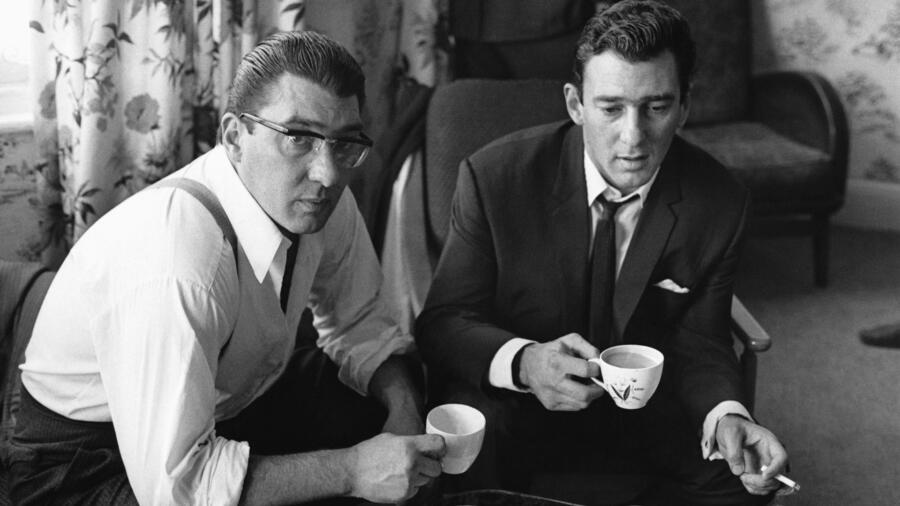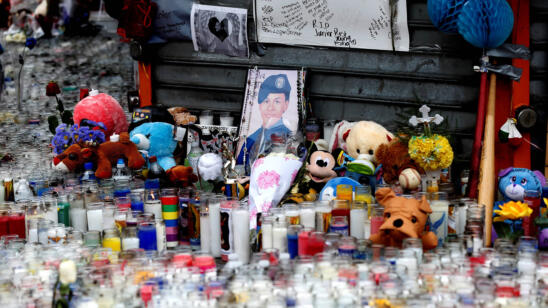If funerals are the measure of fame, British twin gangsters Ronnie and Reggie Kray, who mixed with celebrities during London’s Swinging Sixties, were the stuff of legend.
Ronald “Ronnie” Kray had been imprisoned for 26 years for two murders when he died of a heart attack in 1995. His twin Reginald “Reggie” Kray died five years later of bladder cancer, after spending 31 years behind bars, also for murder. Both their London funerals were prodigious affairs.
A ‘Royal’ Funeral for Ronnie Kray
“The streets were packed, as for a royal occasion,” Nemone Lethbridge, a lawyer for the brothers, says about Ronnie Kray’s massive funeral procession in the documentary Biography: The Kray Twins.. “I’ve never seen anything like it. It was quite extraordinary.”
With no live gangster to gawk at anymore, Reggie Kray’s funeral was smaller, but still attracted thousands of people and featured hundreds of floral tributes on the pavement outside the funeral parlor.
“The funerals were incredible,” Kray biographer John Pearson says in the documentary.
The identical twins, born in 1933 and raised in London’s East End, rose to notoriety as nightclub and gambling club owners who ran fraud and protection rackets and were involved in assaults and armed robberies. All the while, they socialized with stars such as Judy Garland, Diana Dors and Barbara Windsor.
Reggie Kray had a brief relationship with Windsor, who also dated the twins’ older brother, Charlie Kray. “East End social life saw showbusiness intermingling with local gang culture,” BBC News says in Windsor’s obituary.
The Kray Twins’ Clubs Attracted Celebrity Clientele
The Krays’ first club in London, The Round R, attracted actresses Jackie Collins and Sybil Burton, Pearson writes in his book, The Profession of Violence: The Rise and Fall of the Kray Twins. The club’s formula for success was “the orderly raucousness, the sentimental cockney songs of Queenie Watts, the villains mixing with celebrities and the regular presence of several large but well-behaved old boxers,” he writes.
The Krays owned other clubs, including Esmeralda’s Barn, which they turned into a gambling club and drew regulars like painters Francis Bacon and Lucien Freud.
A scandal erupted in 1964, when the Sunday Mirror published a story linking Ronnie Kray, who identified as bisexual in his autobiography My Story, to prominent politician Lord Boothby. Homosexuality was only decriminalized in England in 1967.
“Our paper issued an apology and paid out £40,000 compensation (more than $1 million in U.S. dollars today) after hinting Boothby and Ronnie were having an affair,” The Mirror writes in 2020. “They weren’t, but the truth was far more damaging.”
The United Kingdom’s Security Service agency, MI5, released papers in 2015 that revealed the twins frequented their West End gambling dens and clubs to ‘hunt’ for young men” for sex.
In a BBC interview in the 1960s, the Kray twins were asked if London’s clubs were tough. “I don’t suppose it can be that bad, or those people wouldn’t go to them, would they?” Reggie Kray says. “I think most clubs are very respectable and I don’t think there’s any trouble at all in them … except occasionally,” Ronnie Kray says.
All three Kray brothers were photographed in 1965 by famed British fashion photographer David Bailey. A photograph of them wearing suits and skinny ties is included in Bailey’s “Box of Pin-Ups” that documented 1960s British celebrity culture alongside icons like the Beatles and the Rolling Stones. “The portrait became gangland’s Mona Lisa: copied, pirated and imitated, it was central to their image and their brand,” writes Duncan Campbell in The Guardian.
Violent Streaks That Led to Murder
The Kray twins were both ruthless, but very different. Reggie had the most business acumen while Ronnie was volatile and unpredictable and eventually was diagnosed with paranoid schizophrenia. “Without his brother, [Reggie would have made a definite success of crime and almost certainly have been a rich man and a free one to this day,” Pearson writes in his book.
Their nefarious reign mostly came to a halt in 1969, when they were 36 and were sentenced to life in prison after England’s longest and most expensive murder trial at the Central Criminal Court of England and Wales. Both were found guilty in the killing of Jack “the Hat” McVitie, one of their enforcers; Ronnie was also found guilty in the killing of George Cornell, a rival criminal who’d called him “a fat poof.” (“Poof” is offensive British slang for a gay man.)
Reggie Kray was imprisoned at Parkhurst Prison on the Isle of Wight, England. At first, Ronnie Kray was sent there, too, but a decade later he was committed to Broadmoor Hospital, a high-security psychiatric facility about 70 miles away.
The Twins’ Lives Behind Bars
Even behind bars, the Kray twins continued to run a bodyguard and protection business whose clients included Frank Sinatra, according to the Daily Mail. “Sinatra was said to have recruited an 18-strong team of bodyguards from the firm, Krayleigh Enterprises, before his June 1985 visit to the Wimbledon tennis tournament.”
Both twins were married twice. Reggie Kray’s first wife, Frances Shea, committed suicide in 1967. Reggie Kray met his second wife, Roberta Jones, while in prison; Ronnie Kray also met his wives, Elaine Mildener and Kate Howard, while locked up.
“From prison, the twins actually made murder pay,” Pearson writes in his book. “They had their fan club, their literary agent, their publishers, and for a period, Reggie engaged a public relations man to boost his image and get him favourable media coverage.”
When their mother Violet Kray died in 1982, the news that the twins were allowed out of prison to attend her funeral—their first public appearance in 13 years—made headlines across the United States and Canada.
“They sat at the front of a congregation that included movie star Diana Dors, once Britain’s answer to Jayne Mansfield,” says the Hartford Courant.
Throngs of people also showed up at Charlie Kray’s funeral in 2000, with Reggie Kray, the only twin alive, in attendance.
“There was this enormous emotion going right through this crowd, the likes of which I’d never seen before or since. And it came to a climax when Reg was brought in,” Pearson says in Biography: The Kray Twins about Charlie Kray’s funeral. “By then, he was very ill. He was a little frail guy with gray hair. He was like some very old, sort of … king across the water, who’d come back to his kingdom.”
Related Features:
John Gotti: Why Did the Working Class Love the Mobster So Much?
‘The Iceman’: An Undercover Agent Reflects on Taking Down Notorious Hitman Richard Kuklinski


